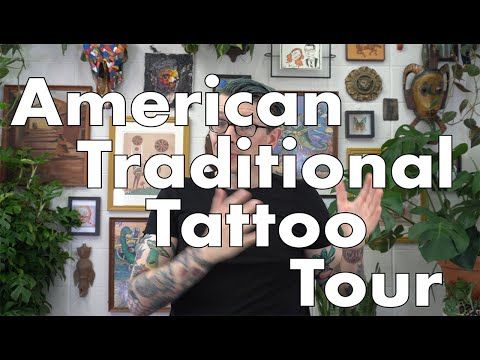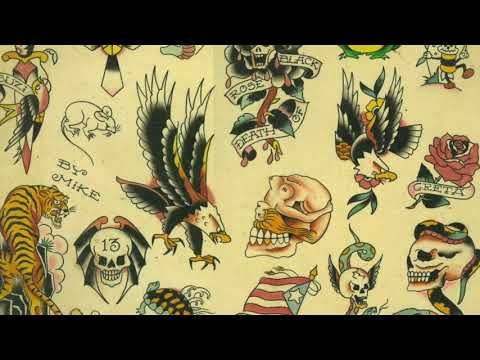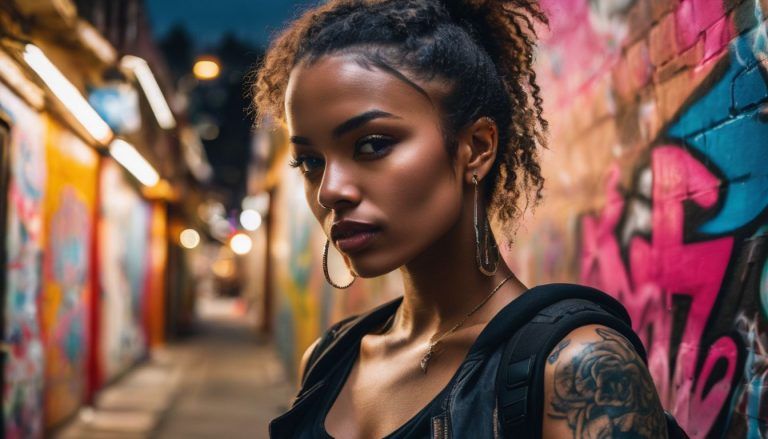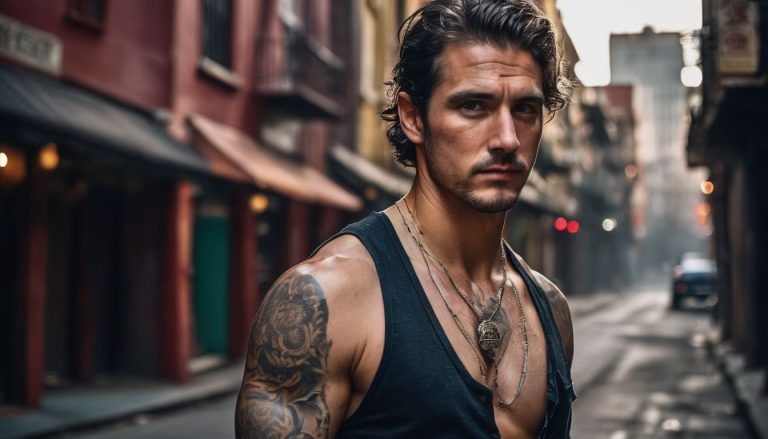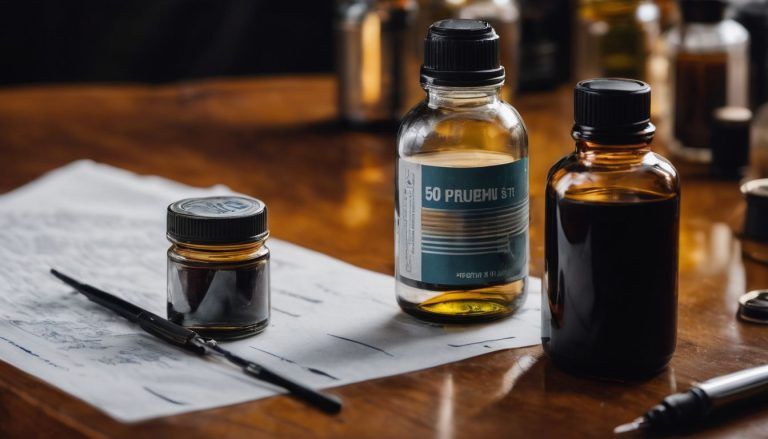The History and Meaning of American Traditional Tattoos
Curious about the bold tattoos you see in old movies or on veterans? American traditional tattoos have a rich history dating back to the early 1900s. We’ll dive into their origins, meanings, and why they’re still popular today, offering insight for tattoo enthusiasts and history buffs alike.
Discover their vibrant stories with us!
Key Takeaways
- American traditional tattoos have roots in the experiences of sailors and military service members, with iconic designs influenced by naval imagery and Japanese tattooing.
- Classic motifs such as birds, ships, hearts, animals, swords, and weaponry hold symbolic significance reflecting nautical themes, romantic symbolism, bravery, and resilience.
- The revival and mainstream appeal of traditional tattoos stem from countercultural movements like biker and punk subcultures before being reinterpreted through modern lenses while still paying homage to their historical roots.
The Origins of American Traditional Tattoos
Sailor Jerry, a prominent tattoo artist, played a significant role in the development of American traditional tattoos with his iconic designs influenced by naval imagery. Additionally, Japanese tattooing also had a strong influence on the style through its introduction to Western culture.
Sailor Jerry & the influence of naval tattoos
Norman ‘Sailor Jerry’ Collins became a pivotal figure in shaping the American Traditional tattoo style. His bold, iconic designs were deeply influenced by his time at sea and encounters with sailors.
The Navy culture of the early 20th century played a significant role in spreading tattoo art. Sailors often chose tattoos that represented their experiences or aspirations—a tradition Sailor Jerry understood well and integrated into his craft.
As a result, naval tattoos featuring classic motifs such as anchors, ships, and swallows became symbols of maritime life inked onto the skin of many service members. These designs served not only as personal talismans but also as markers of identity within the naval community.
Sailor Jerry contributed to this body art tradition by adding vibrant colors and refining iconlike designs that would stand the test of time, influencing generations to come.
The impact of Japanese tattooing on American traditional style
Japanese tattooing had a significant impact on the development of American traditional style. During the 19th and early 20th centuries, Japanese tattoo art began to influence Western traditional tattoos.
This influence is evident in the bold outlines and vibrant colors that characterize American traditional tattoos today. Traditional Japanese motifs such as dragons, koi fish, and cherry blossoms also made their way into American designs, adding new elements to the classic repertoire of old school tattoos.
The fusion of Japanese tattooing with American traditional style brought a fresh infusion of symbolism and imagery to Western inked culture. By incorporating iconic tattoo symbols from Japan, such as kitsune (foxes) and hannya masks, American traditional tattoos evolved beyond their naval and patriotic roots to embrace a broader range of influences.
Common Motifs in American Traditional Tattoos
American traditional tattoos often feature classic motifs such as birds, ships, hearts, and animals. These designs draw on nautical themes, romantic symbolism, and elements of nature to create enduring and iconic tattoo images.
Birds, ships, and nautical themes
American traditional tattoos often feature iconic designs such as birds, ships, and nautical themes. These classic motifs hold symbolic significance and reflect the historical influence of sailors and naval traditions on tattoo art.
- Birds: Birds, especially swallows and sparrows, were commonly tattooed by sailors to symbolize their voyages at sea. These avian designs represented freedom, safe passage, and the hope of returning home.
- Ships: Ship tattoos are emblematic of the maritime life embraced by sailors. They signify journeys taken, adventures experienced, and a deep connection to the sea. The intricate details in ship tattoos often showcase the craftsmanship of skilled tattoo artists.
- Nautical Themes: Other nautical motifs such as anchors, compasses, and ropes are prevalent in American traditional tattoos. These images reflect a reliance on navigation equipment, strength in adversity, and protection during perilous travels.
- Meaningful Symbolism: Each of these designs holds a deeper meaning beyond aesthetic appeal – showcasing elements like freedom, adventure, and resilience that resonate with those who wear them.
- Influential Evolution: As American traditional tattoos have evolved over time, these timeless symbols continue to be cherished by enthusiasts seeking to honor their historical roots while embracing contemporary interpretations of this iconic style.
Hearts, flowers, and romantic symbolism
Following the iconic nautical motifs in American traditional tattoos, hearts, flowers, and romantic symbolism also hold significant meaning in this style. These designs often represent love, passion, and sentimental values in tattoo culture. Here are common romantic motifs found in American traditional tattoos:
- Hearts: Symbolize love, affection, and devotion. Often depicted with banners inscribed with names or dates to commemorate a loved one.
- Roses: A classic symbol of love and beauty. Whether solitary or entwined among thorns, roses convey timeless romance and passion.
- Swallows: Often paired with a heart or banner, swallows symbolize undying love and loyalty due to their fidelity to one partner for life.
- Anchors: Paired with hearts or entwined by roses, anchors symbolize stability in relationships and the steadfast nature of enduring love.
- Cupid: Representing desire, attraction, and affection, Cupid’s arrow-through-heart motif captures the essence of true love in American traditional tattoos.
- Lock-and-key: Depicting an unbreakable bond or eternal commitment between partners; this motif symbolizes trust and unity within relationships.
- Cherries: Often depicted as a pair dangling from a stem or placed inside a heart; cherries represent innocence, purity, sweetness, or youthful affection.
Animals and nature
American traditional tattoos often feature animals and nature as part of their classic designs. These motifs hold specific meanings and symbolism that have been cherished for generations.
- Animals such as eagles, panthers, snakes, and swallows are commonly depicted in American traditional tattoos. These creatures symbolize strength, freedom, and resilience.
- Nature elements like roses, oak leaves, and lighthouses are also prevalent in traditional tattoo designs. They represent beauty, endurance, and guidance amid challenges.
- American traditional tattoos frequently incorporate wildlife imagery including wolves, bears, and deer to convey traits like courage, ferocity, and instinctual wisdom.
- Nautical themes like anchors and ships adorned with sea creatures such as octopuses or mermaids are emblematic of adventure, perseverance, and the unknown depths of the ocean.
- The use of animals and nature in American traditional tattoos reflects a deep connection to the natural world alongside enduring values of bravery, loyalty, and the pursuit of liberty.
Swords, daggers, and other weaponry
Continuing with the array of classic motifs, let’s delve into the significance of swords, daggers, and other weaponry in American traditional tattoos.
- These symbols are often associated with bravery and courage, harking back to a time when warriors relied on these weapons for protection and strength.
- Swords and daggers can also represent honor and loyalty, tying in with the themes of chivalry and duty commonly found in traditional tattoo designs.
- Anchored in history, these images embody a sense of masculinity and resilience, serving as a reminder of the wearer’s inner fortitude.
- Additionally, weaponry motifs may symbolize a readiness to face challenges head-on and defend oneself against adversity.
- Often depicted with bold black outlines and vibrant primary colors, these emblems exude power and determination, making them enduring choices for those seeking timeless tattoo art.
Evolution and Popularity of American Traditional Tattoos
American traditional tattoos became popular among biker and punk subcultures in the 20th century before experiencing a revival and mainstream appeal in recent times. Read more to learn about the history and meaning of these iconic tattoo designs.
Rise of the biker and punk subcultures
The biker and punk subcultures played a pivotal role in the evolution of American traditional tattoos. During the mid-20th century, these countercultural movements embraced tattoos as symbols of rebellion and nonconformity.
Bikers adorned themselves with iconic tattoo designs such as skulls, daggers, and motorcycles, while punks sought to express their anti-establishment ethos through bold and vibrant tattoo art.
As a result, traditional tattoo motifs became intertwined with the edgy aesthetic of these subcultures, fueling the popularity and mainstream appeal of old school tattoos.
The revival and mainstream appeal of traditional tattoos
As the biker and punk subcultures gained popularity, traditional tattoos experienced a resurgence in mainstream appeal. This revival brought classic tattoo motifs such as eagles, pin-up girls, nautical symbols, and patriotic imagery back into the spotlight.
Moreover, fueled by a renewed interest in vintage tattoo styles and Americana culture, artists began incorporating bold outlines and vibrant colors into their designs. The limited color palette of primary colors alongside thick black outlines became iconic features of traditional American tattoos.
Tattoo history saw a resurgence with the growing appreciation for old school tattoos stemming from their founding artists like Norman ‘Sailor Jerry’ Collins. These classic designs took on new life as they were reinterpreted through modern lenses while still paying homage to their historical roots.
Symbolism and Meaning of American Traditional Tattoos
American traditional tattoos often symbolize love, loyalty, and patriotism, reflecting the values of Americana tattoo culture. Read on to explore the deep meanings behind these iconic designs.
Love, loyalty, and patriotism
Love, loyalty, and patriotism are prevalent themes in American traditional tattoos. These designs often feature classic symbols such as hearts, roses, anchors, and American flags. Sailors and military service members would get these tattoos to express their affection for loved ones back home and their dedicated allegiance to their country.
The strong emotional connection associated with these motifs has made them timeless staples of the traditional tattoo style.
Patriotic imagery like eagles, Lady Liberty, or symbols of the armed forces also hold significant meaning in American traditional tattoos. These images serve as a visual representation of one’s pride and devotion to America.
Strength, bravery, and masculinity
American traditional tattoos symbolize strength, bravery, and masculinity, reflecting the rugged nature of early American culture. These designs often feature bold images of iconic figures such as eagles and military insignia to embody valor and courage.
The use of primary colors like red and blue in these tattoos further enhances their strong, masculine appeal. Traditional tattooing has a deep connection with symbols of patriotism and honor, creating a visual representation of the enduring spirit associated with the values of strength, bravery, and masculinity.
The motifs found in American traditional tattoos reflect a sense of resilience and determination that is deeply rooted in the history and heritage of the country. The vivid imagery serves as a visual narrative for tales from the past involving battles fought by brave soldiers at sea or on land.
Superstitions and talismanic tattoos
Rooted in a belief system of protection and good fortune, superstitions and talismanic tattoos hold significant cultural meaning. Engrained within the American traditional tattoo style are symbols thought to ward off evil spirits or bring luck to the bearer.
Symbols like horseshoes, four-leaf clovers, and lucky numbers have been popular choices for those seeking protective or fortuitous elements in their tattoos. In addition to these charms, renditions of historic icons such as the all-seeing eye and ancient runes continue to be incorporated into modern American traditional designs.
Incorporating superstitious and talismanic motifs into traditional tattoos reflects a desire for spiritual connection and symbolic protection. These timeless emblems persist as enduring fixtures within American traditional tattooing, offering wearers a sense of safeguarding while celebrating tradition.
Modern Interpretations of American Traditional Tattoos
Modern interpretations of American traditional tattoos have embraced bold and colorful designs, departing from the original black ink style. Traditional motifs are often fused with other tattoo styles and influences, and social media and celebrity culture have greatly impacted the popularity of these tattoos.
Bold and colorful designs
American traditional tattoos are characterized by bold and colorful designs, with thick black outlines and vibrant primary colors. These designs typically feature iconic motifs such as eagles, pin-up girls, roses, and nautical symbols like anchors and ships.
The use of bold lines ensures that the tattoo stands out and retains its clarity over time. The striking color palette of American traditional tattoos adds to their timeless appeal, making them a popular choice for those seeking classic yet visually impactful body art.
The bold and colorful nature of American traditional tattoos has contributed to their enduring popularity in mainstream tattoo culture. Their distinctive appearance makes them instantly recognizable, while the vivid hues used in these designs create a sense of energy and dynamism on the skin.
Fusion with other styles and influences
Fusion with other styles and influences takes traditional American tattoos into new territory, combining bold and vibrant designs with elements from other tattooing traditions. This fusion results in unique pieces that blend the primary color palette and strong outlines of traditional American tattoos with techniques and motifs from different cultural backgrounds.
It creates a dynamic interplay between classic American imagery and diverse artistic influences, ushering in an era of innovation and experimentation within the tattoo community.
The fusion with other styles draws on the rich history of tattooing worldwide, incorporating ideas from Asian, Polynesian, or tribal art to create fresh interpretations of traditional American designs.
The impact of social media and celebrity culture
Social media and celebrity culture have significantly influenced the popularity of American traditional tattoos. Bold, colorful designs often feature prominently on celebrities’ social media platforms, driving interest in this timeless style.
Vibrant tattoo colors are showcased by famous personalities, attracting diverse audiences seeking to emulate their favorite stars’ iconic ink. Primary color tattoos gain exposure through celebrity endorsement and representation in popular culture, contributing to the rising appeal of American traditional tattoos among a wider demographic.
The history of American traditional tattoos is intertwined with cultural significance and symbolism; however, modern interpretations fuse classic designs with contemporary influences.
Conclusion
In conclusion, American traditional tattoos have a rich history rooted in the experiences of sailors and military service members. The bold and colorful designs continue to hold deep meanings tied to love, loyalty, bravery, and patriotism.
Modern interpretations fuse traditional elements with other styles, influenced by social media and celebrity culture. The evolution from sailor tradition to mainstream popularity reflects the enduring appeal of these iconic designs.
FAQs
1. What are American Traditional Tattoos?
American Traditional tattoos are bold, colorful designs with strong outlines and iconic symbols that have a rich history in tattoo culture.
2. How did American Traditional tattoos start?
Tattoo history shows that American traditional tattoos began with sailors and soldiers who got inked as mementos of their journeys and experiences.
3. What kinds of designs are common in American Traditional Tattoos?
Common designs include nautical themes like anchors or ships, animals like eagles or snakes, and heart or rose symbols which all carry special meanings.
4. Can anyone get an American Traditional Tattoo?
Yes! Anyone interested in the style can get an American Traditional tattoo to connect with the historical meaning or just because they love the timeless look.


